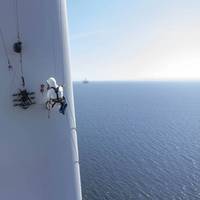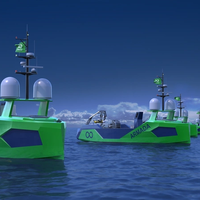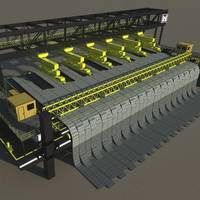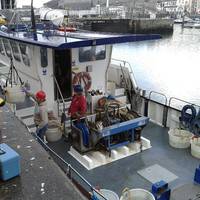Armach's Hull Service Robot Excels in Over-the-horizon Operation Trials

Armach Robotics said on Tuesday that it had reached a major milestone by operating its hull cleaning robot successfully in full over-the-horizon (OTH) mode.In the water in Norfolk, VA, Armach’s hull service robot, was earlier this month monitored and controlled by staff at Armach’s command center in Plymouth, MA, using a 4G modem providing over-the-air connectivity.Once the communications connection was made between Norfolk and Plymouth, the vehicle was able to complete its pre-dive checks on the pier.
In Offshore Energy, the Winds of Robotic Change are Blowing

Whether we realize it or not, robotics and robotics systems are starting to impact our daily lives. From warehouse picking systems through to high-end medical devices through to your mowbot lawnmower. Each tends to be specialized to its own task and a similar trend is now starting to play out in the offshore wind space, where it’s hoped that robots can make operations safer and more efficient.According to a report, The Economic Opportunity for Robotics in Offshore Wind and Key Energy Markets by the Offshore Renewable Energy Catapult (ORE Catapult)…
Sonardyne's Sensors for Ocean Infinity's Armada USV Fleet

Ocean Infinity, a U.S. based marine survey firm developing the world's largest fleet of unmanned surface vessels - Armada - has ordered Sonardyne sensors for its robotic vessels.As reported previously, Ocean Infinity in February launched Armada, a marine technology and data company boasting the industry's largest fleet of unmanned surface vehicles (USV).Sonardyne said Wednesday it would provide the first wave of Ocean Infinity’s new Armada fleet with key sensor technologies for underwater platform navigation…
Mat Sinking Unit in Modernization Drive

Millions of dollars of goods are transported up and down the Mississippi every year. This transportation is made possible, in part, by the U.S. Army Corps of Engineers (USACE) Mat Sinking Unit and its crew, who work tirelessly each season to protect the riverbanks with concrete mats and prevent erosion.The Mat Sinking Unit was built in 1940, widened in 1960 and is being replaced over the next several years with new and improved plant. The new design will double the number of mat squares that can be placed in a season.USACE Vicksburg District (MVK)…
Robot Fleet Completes Pioneering Mission
The second phase of an ambitious project to gather valuable information on ocean processes and marine life using a fleet of innovative marine robots has just reached its conclusion. Co-ordinated by the National Oceanography Centre (NOC), the Exploring Ocean Fronts project took place off southwest England and saw the largest deployment of robotic vehicles ever attempted in UK waters. The marine robots, which are powered by a combination of wave, wind and solar power, are controlled by satellite communications and can cover hundreds of kilometres in a single mission. In the latest phase of the project, three unmanned surface vehicles were used to track fish carrying acoustic ‘pingers’ off the Devon coast.
Robot Vehicles Embark on Fish Tracking Mission

Three marine robot vehicles have been launched from Plymouth today to undertake a fish tracking mission in and around new Marine Protected Areas (MPAs). Scientists from the Marine Biological Association (MBA) and engineers from the National Oceanography Centre (NOC) are working together on this pioneering project to study how fish use these areas on a day-to-day basis. Using acoustic pingers, plaice, sole, brill and rays are being tracked at sea by the ocean robots programmed…
SHI Develops RTLinux Powered Robots
FSMLabs, a software developer announced that Samsung Heavy Industries Shipbuilding Division (SHI) has selected RTLinuxPro as the base for its robotics systems and has several advanced RTLinux powered robots in production use. Working with FSMLabs' Korean partner, RealTimeWave, engineers at SHI have created some of the worlds most advanced ship-building robots including an autonomous “Spider” welder that autonomously guides itself over the ships membrane wall. In addition to the Spider robot, SHI has developed a RTLinux powered pipe alignment robot also in production use and a third, Stewart-Gough Type 6-axes parallel robot is under development. The robots use SHI designed 3-D path tracking and real-time attitude control systems.





